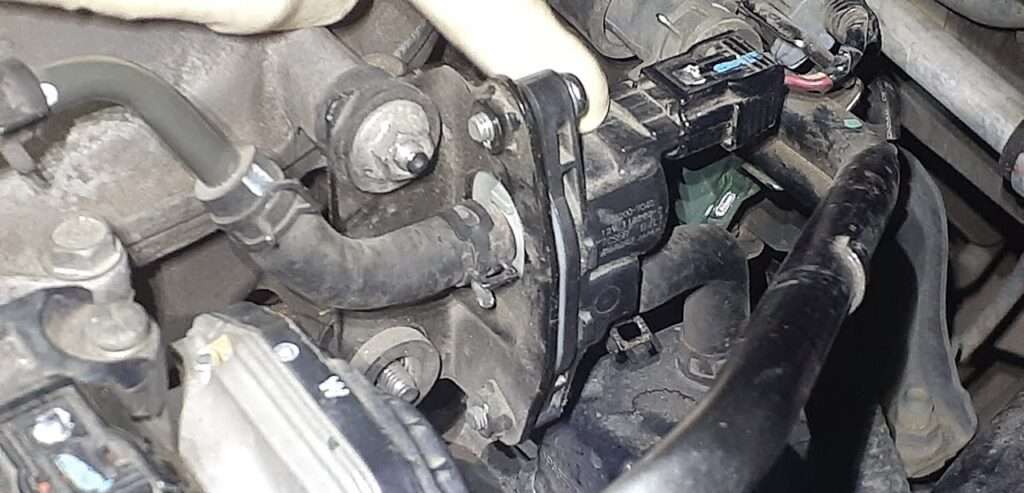
P0497 Low flow during purge in the evaporative emission system
Content
P0497 – OBD-II Trouble Code Technical Description
Trouble code P0497 indicates a problem with the evaporative emission control system, namely low flow in the system during purge.
What does the fault code mean P0497?
Trouble code P0497 indicates a problem in the evaporative emission system due to low pressure in the system during purge. The fuel vapor recovery system is designed to prevent fuel vapor from leaking into the atmosphere. During engine operation and fuel combustion, excess fuel vapor is directed to the carbon filter of the fuel vapor recovery system. The pressure created by the process is released through the vent line and vent valve, and fuel vapors accumulate in the charcoal canister until the engine uses them up. If there is a leak or other problem in the system, the PCM (engine control module) detects the pressure difference and stores P0497 in its memory.

Possible reasons
Some possible reasons for the P0497 trouble code:
- Defective Vent Valve: If the vent valve does not close properly or is blocked, it can cause low pressure in the evaporative emission system.
- Damaged Vent Line: Damaged or clogged vent lines can prevent the normal flow of fuel vapor, which will also result in low system pressure.
- Carbon Filter Problems: If the charcoal filter is clogged or damaged, it may not do its job of catching fuel vapors properly, resulting in low pressure.
- Pressure Sensor Problems: A faulty evaporative emission system pressure sensor may give an incorrect pressure reading, causing a P0497 code.
- PCM Problems: In rare cases, the PCM itself may be damaged or have software errors, causing it to incorrectly detect system pressure.
What are the symptoms of a fault code? P0497?
When trouble code P0497 occurs, you may typically experience the following symptoms:
- The appearance of a “Check Engine” error or similar indicator on the instrument panel.
- Poor engine performance or uneven idle speed.
- Poor fuel economy or increased fuel consumption.
- There may be a smell of fuel or its presence under the car due to leakage of fuel vapors.
- Poor operation of the air conditioning or heating system, especially at low engine speeds.
How to diagnose a fault code P0497?
To diagnose DTC P0497, the following steps are recommended:
- Error checking: Use a diagnostic scan tool to read the error code and any additional codes that may help determine the cause of the problem.
- Checking the evaporative emission system: Visually check the evaporative emission system for leaks, damage, or connections that may be loose. Pay attention to the condition of the carbon filter and its connections.
- Checking vacuum tubes and valves: Check the vacuum tubes and valves in the evaporative emission system for leaks or damage.
- Sensor testing: Check the operation of the pressure and temperature sensors in the fuel vapor recovery system. Make sure they work correctly and produce the correct values.
- Checking the air flow: Check for obstructions in vent lines or valves that could cause improper air flow.
- System Pressure Testing: Use a pressure gauge to check the evaporative emission system pressure and compare it to the manufacturer's recommended values.
- Checking electrical connections: Check the electrical connections and connectors in the evaporative emission system for corrosion, oxidation or damage.
- Additional tests: If necessary, perform additional tests, such as testing the motor or other system components, to rule out problems with their operation.
After diagnosing and fixing the problems found, you need to clear the error code and conduct a test drive to check the operation of the system and make sure that the problem was successfully resolved.
Diagnostic errors
When diagnosing DTC P0497, the following errors may occur:
- Omitting Important Components: Some technical details or components of the evaporative emission control system may be missed during diagnosis, which may lead to incomplete conclusions about the condition of the system.
- Misinterpretation of data: Incorrect interpretation of sensor readings or test results may lead to incorrect diagnosis and erroneous determination of the cause of the malfunction.
- Faulty Components: Some evaporative emission control system components may be faulty but not show obvious signs of failure upon initial inspection, which may result in the problem being missed.
- Inadequate testing: Incomplete or insufficient tests performed may not identify all problematic aspects of the system, resulting in an incomplete diagnosis.
- Interference with other systems: Problems with other vehicle systems, such as the ignition system or fuel injection system, can lead to diagnostic confusion and misidentification of the cause of the problem.
To prevent these errors, it is important to diagnose carefully, follow the manufacturer's manual, and use reliable testing and diagnostic equipment. If you are unsure of the diagnostic results, it is better to contact a specialist or certified auto mechanic.
How serious is the fault code? P0497?
Trouble code P0497, indicating low evaporative emission system pressure, is usually not critical to the safety or immediate performance of the vehicle. However, it can lead to deterioration of the vehicle's environmental performance and increased fuel consumption.
Although this code itself is not extremely serious, its cause may require careful attention and timely repair to avoid increased emissions and fuel loss. Additionally, ignoring this code may result in further malfunctions or damage to other evaporative emission system components, which can ultimately lead to more serious problems.
What repair will help eliminate the code? P0497?
To resolve DTC P0497, the following steps are recommended:
- Check the fuel level: Check how full the fuel tank is. Low fuel level can cause low pressure in the evaporative emission system.
- Check for Leaks: Inspect the evaporative emission system for leaks. Possible leak locations include fuel lines, charcoal canister, and gaskets.
- Check the vent valve: Make sure the vent valve is working properly and is not stuck open.
- Check the carbon filter: Check the condition of the carbon filter. It may become full or blocked, reducing the effectiveness of the evaporative emission system.
- Check the pressure sensor: Check the evaporative emission system pressure sensor for proper operation. If the sensor fails, it may give incorrect signals about the pressure in the system.
- Parts Replacement: Replace any worn or damaged evaporative emission system components as necessary.
- Cleaning and Reprogramming the PCM: If necessary, clear or reprogram the PCM to clear P0497 after repairs are completed.
After repair work is completed, it is recommended that you take a test drive and re-diagnosis to ensure that the P0497 trouble code no longer appears.
P0497 – Brand-specific information
Trouble code P0497 is related to the evaporative emission system and can be found in various makes of vehicles. Here is a list of some car brands with their decodings:
- Audi: Evaporative emission control system sensor error.
- BMW: Low pressure in the fuel vapor recovery system.
- Chevrolet: Problem with the evaporative emission system.
- Ford: Low pressure in the evaporative emission system.
- Honda: Problem with pressure in the fuel vapor recovery system.
- Hyundai: Insufficient pressure in the fuel vapor recovery system.
- Mercedes-Benz: Evaporative emission system ventilation error.
- Nissan: Problem with the pressure sensor in the fuel vapor recovery system.
- Toyota: Low pressure in the fuel vapor recovery system.
- Volkswagen: Evaporative emission system error.
These are just a few examples of car brands that may experience the P0497 code. Each manufacturer may use their own terms and interpretation for this DTC. For more accurate information, please refer to the repair manual for your specific vehicle make and model.

